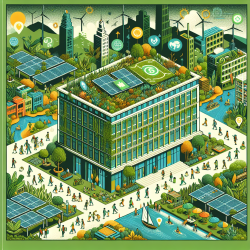Introduction
As climate change intensifies, the frequency and severity of extreme heat events are increasing, posing significant health risks to communities. The built environment plays a crucial role in both contributing to and mitigating these effects. A systematic review titled "Associations between Green Building Design Strategies and Community Health Resilience to Extreme Heat Events" explores how green building practices can enhance community resilience to such climatic events. This blog aims to provide practitioners with insights from this research to improve their skills and encourage further exploration in this area.
Understanding the Research
The systematic review, conducted using the PRISMA method, assessed the potential for LEED (Leadership in Energy and Environmental Design) credit requirements to reduce the adverse effects of extreme heat events. The review identified 12 LEED credits that could enhance a building's passive survivability and contribute to public health co-benefits, such as reducing heat-related morbidity and mortality.
Key Findings
The research highlights several green building strategies that can mitigate the urban heat island effect, a significant factor in heat-related health risks. These strategies include:
- Increasing vegetated open spaces to improve microclimate thermal comfort.
- Utilizing light-colored and vegetated roofs to reduce heat absorption.
- Implementing energy-efficient designs to decrease reliance on air conditioning and reduce the burden on electrical grids during peak demand.
These strategies not only reduce exposure to extreme heat but also provide co-benefits such as improved air quality and reduced energy consumption.
Practical Implications for Practitioners
Practitioners in the field of building design and public health can leverage these findings to enhance community resilience. By integrating green building strategies into design processes, practitioners can address both environmental and health outcomes. This approach requires collaboration across sectors, including public health, civil society, and urban planning.
Practitioners are encouraged to prioritize LEED credits that align with the specific needs of their projects and communities. For example, in areas with vulnerable populations, increasing vegetation and implementing energy-efficient systems can significantly reduce heat stress risks.
Encouraging Further Research
While this review provides a strong foundation, further research is needed to explore the causal pathways and strength of associations between specific green building strategies and health outcomes. Practitioners are encouraged to engage in research collaborations to expand the evidence base and develop innovative solutions for climate resilience.
Conclusion
Green building practices offer a promising avenue for enhancing community resilience to extreme heat events. By integrating these strategies into design and planning processes, practitioners can contribute to healthier, more sustainable communities. To delve deeper into the research findings, practitioners can access the original research paper: Associations between Green Building Design Strategies and Community Health Resilience to Extreme Heat Events: A Systematic Review of the Evidence.










